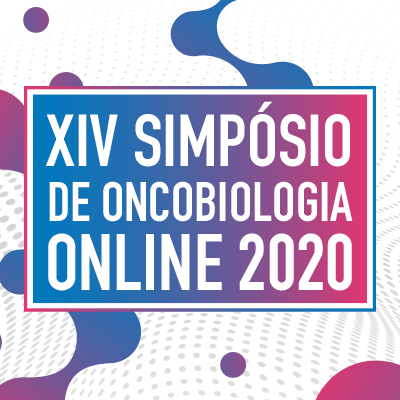Proceedings of Oncobiology Symposiums
Proceedings of XIV Oncobiology Symposium
PROTEOMIC ANALYSIS OF HER-2 POSITIVE BREAST CANCER RESISTANT TO TRASTUZUMAB TREATMENT
How to cite this paper?
To cite this paper use one of the standards below:
How to cite this paper?
- Presentation type: IC - Undergraduate Students
- Track: Genomics, Proteomics and Metabolomics
- Keywords: Breast cancer; HER-2; Trastuzumab; Proteomic;
Authors:
- 1 Universidade Federal do Estado do Rio de Janeiro
- 2 Universidade Federal do Rio de Janeiro
- 3 Molecular and Cell Biology Program, INCA Brazilian National Cancer Institute, RJ/Brazil.
Please log in to watch the video
Log in- Presentation type: IC - Undergraduate Students
- Track: Genomics, Proteomics and Metabolomics
- Keywords: Breast cancer; HER-2; Trastuzumab; Proteomic;
Authors:
- 1 Universidade Federal do Estado do Rio de Janeiro
- 2 Universidade Federal do Rio de Janeiro
- 3 Molecular and Cell Biology Program, INCA Brazilian National Cancer Institute, RJ/Brazil.
INTRODUCTION AND OBJECTIVES: Breast cancer is one of the most common types of cancer among women in Brazil and worldwide. In the years 2020-2022, it is estimated that 66,280 new cases of breast cancer will appear each year in Brazil. Amplification of HER2 in breast cancer is seen in about 20% of these cases and correlates with reduced disease-free survival and overall survival. Her-2 protein belongs to the epidermal growth factor (EGFR) receptor family, linked to the tyrosine kinase receptor superfamily. Interactions between the intracellular medium and the extracellular matrix are important for determining cell morphology, growth and differentiation. These interactions are due in part by action of integrins, transmembrane glycoproteins which constitute a large family of heterodimers responsible for modulating signals of proliferation, adhesion, motility and cellular polarity. Integrins and receptors of the EGFR family display a cooperative signaling network in tumor formation, which is a common feature of invasive cancer cells. One of the monoclonal antibodies approved to inhibit this type of tumor, Trastuzumab, is widely used in the clinic, however, 70% of patients acquire resistance throughout the treatment. The analysis of the proteomic profile of these treated and untreated breast tumors can provide a more in-depth knowledge about the resistance mechanisms, thus enabling the development of new, more effective therapies for the treatment of these patients. Here, we investigate the differences in the proteomic profiles of the cell line HCC-1954 treated and untreated by trastuzumab. MATERIAL AND METHODS: We used cell viability analysis, in gel hydrolysis of proteins, analysis by mass spectrometry and Western blot, in addition to in silico studies using the online tools Mascot, String and Panther. RESULTS AND CONCLUSION: Cell viability assays showed the resistance of the HCC1954 cell line to treatment with Trastuzumab in different concentrations. Protein classification in GO highlighted the integrin signaling pathway, presenting proteins related to migratory processes such as Transforming protein RhoA, Cell division control protein 42 and Integrin β-1 in the treated cell , while in the untreated cell, proteins of the actin family were identified. It also highlights the difference in the constitution of exclusive proteins from untreated and treated cells classified in the Wnt, CCKR, Ras and Cadherin signaling pathways. The String network showed the interactions between uniquely identified proteins and the Her-2 receptor in cells with and without Trastuzumab. Western blot results suggest an increase in the intensity of β1 integrin in the HCC-1954 (resistant) cell line and a decrease in intensity in the BT-474 (sensitive) cell line after treatment with trastuzumab. The results suggest that the integrin signaling pathway may be one of the mechanisms of resistance to the treatment with Trastuzumab, more studies are needed to confirm these results.
Avaliação do pôster
Paloma Souza
Olá Thais,
Boa Tarde! Parabéns pelo seu trabalho. Fiquei com algumas dúvidas.
1- Há quanto tempo você está neste projeto?
2- Qual a concentração proteica utilizada para o ensaio de SDS-Page?
3- Vocês pretendem validar a expressão de alguma proteína identificada na análise in silico?
4 - Quais experimentos vocês pretendem fazer para confirmar o perfil mais migratório/metastático da linhagem resistente?
Obrigada.
Paloma Souza
- 1 answer
Metodologia/Resultados
Mariana Teixeira
Qual a concentração de Trastuzumabe utilizada no tratamento das linhagens nos experimentos de análise de integrina B1? Qual o seu efeito na viabilidade dessas linhagens? E qual seria a concentração utilizada na clínica?
- 1 answer
Thais Freitas Barreto Fernandes
Boa tarde,
Em todos os experimentos as linhagens foram tratadas com 20 ug/ml de trastuzumabe por um período de 72 hs. O Trastuzumabe não afetou a viabilidade da linhagem resistente ao tratamento HCC1954 em nenhuma concentração. A concentração utilizada na clínica não é fixa e pode variar entre 4 mg/kg e 8 mg/kg dependendo do estágio do câncer de mama e da presença ou não de metástases.
Elogio
Antonio Santos
Excelente trabalho , digno de nota e divulgação !
Saudações ,
Professor Wilson Araújo da Silva Jr
- 1 like
- 1 answer
Thais Freitas Barreto Fernandes
Obrigada Professor!
Streamline your Scholarly Event
With nearly 200,000 papers published, Galoá empowers scholars to share and discover cutting-edge research through our streamlined and accessible academic publishing platform.
Learn more about our products:
How to cite this proceedings?
This proceedings is identified by a DOI , for use in citations or bibliographic references. Attention: this is not a DOI for the paper and as such cannot be used in Lattes to identify a particular work.
Check the link "How to cite" in the paper's page, to see how to properly cite the paper


Thais Freitas Barreto Fernandes
Boa tarde Paloma, obrigada! 1- Estou no projeto desde 2018. 2- Nos ensaios de SDS-PAGE utilizamos 30ug de extrato total de proteínas. 3-Por ora, pretendemos validar a expressão de Integrina Beta 1 e observar sua distribuição com outras metodologias. 4- Para confirmar esse perfil na linhagem resistente pretendemos realizar ensaios de wound healing.